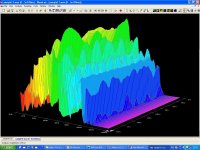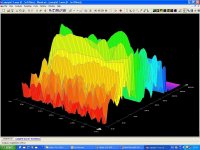We just need to know what key was hit, I might go play with our Steinway.
Its the fourth white key from the left on a standard 88 note keyboard.
Here's another sample. Same note, different piano. This really hits the spot
Attachments
One may also try 'realism' on this sound sample (historical French organ).
Hearing that for the first time (on laptop speakers) and it has a "good quality" to it. I'll try it on the main setup later.
I read years ago an interesting argument and it went something like this...
Everyone (nearly
The question was... if you let someone hear that who had never heard the piece before, would they know that the low pedals were being used or would they think it was all played around the middle of the keyboard.
In such music that you have mentioned, they would not know that low pedals were being used. Part of the music information is simply 'cut' and disappear. This is not difficult to prove if we have a possibility of direct comparison of two speakers with very different low frequency corner. Especially vented boxes cut low frequencies faster.
In such music that you have mentioned, they would not know that low pedals were being used. Part of the music information is simply 'cut' and disappear. This is not difficult to prove if we have a possibility of direct comparison of two speakers with very different low frequency corner. Especially vented boxes cut low frequencies faster.
Yes
I wish I still had the article.... it was years ago in Wireless World I think.
The question was... if you let someone hear that who had never heard the piece before, would they know that the low pedals were being used or would they think it was all played around the middle of the keyboard.
I was at a live recital (8th grade) where someone was playing from Vivaldi's Four Seasons on a violin for several minutes before I recognized it.
I was at a live recital (8th grade) where someone was playing from Vivaldi's Four Seasons on a violin for several minutes before I recognized it.

Their playing was that good
I think i´ve mentioned it before- there was a nice experiment on inattenional deafness using a piece of orchestral music and mixing something unusual in:
https://jyx.jyu.fi/dspace/bitstream/handle/123456789/20887/urn_nbn_fi_jyu-2009411269.pdf
https://jyx.jyu.fi/dspace/bitstream/handle/123456789/20887/urn_nbn_fi_jyu-2009411269.pdf
The brain is “guided” to the absent fundamental by the frequency difference between the harmonics. (Ffund =F2- Ffund, = F3 – F2, =F4-F3, = F5-F4…) The more lower harmonics are absent, the weaker the psychoacoustic effect.
It works well with solo instruments. When other instruments play simultaneously, the effect weakens further.
George
It works well with solo instruments. When other instruments play simultaneously, the effect weakens further.
George
I'm curious what are the spectral characteristics of a single note on a real piano? The FFT's need some massaging to separate AM and FM or extract instantaneous frequency. I suspect a real piano is more AM than FM and the LP is both +.
I first thought I could take a look what acoustic piano sample CDs we have in the studio, but then found this link:
Free Piano Samples!
Analyze as much as you will
Best,
Master a.wayne, I think we've been here before, a few times, in fact ...
One only needs 'ginormous' speakers to get certain types of bass drivers and configurations to function in the lower octaves correctly - otherwise a miniscule enclosure will be sufficient, provided it is relatively inert, and locked solidly to a relatively heavy structure - and, the driver(s) mounted on it are capable of the volumes, and they're being driven by clean electronics.
Nope , all frequencies require percussive energy , you cant get "realistic" from a single 4 inch driver..
Nope , all frequencies require percussive energy , you cant get "realistic" from a single 4 inch driver..
It is safe to say that 4" can't be realistic because even 8" can't. But imagine situations like:
(1) Nearfield listening or small room, floor is used to reinforced the bottom frquency
(2) Reduced sensitivity if necessary to allow for lower frequency relative response and to increase power handling to be driven by high drive power amplifier
(3) TL or sealed enclosure if necessary to get the low
Many times a small driver can be more real than bigger speaker, with the only limitation is the small space it occupies to be perceived bigger and real
It is safe to say that 4" can't be realistic because even 8" can't. But imagine situations like:
(1) Nearfield listening or small room, floor is used to reinforced the bottom frquency
(2) Reduced sensitivity if necessary to allow for lower frequency relative response and to increase power handling to be driven by high drive power amplifier
(3) TL or sealed enclosure if necessary to get the low
Many times a small driver can be more real than bigger speaker, with the only limitation is the small space it occupies to be perceived bigger and real
ADD:
Actually it is IMO less possible to do this by lowering sensitivity ala LS/3A or Totem because the necessary reverberation will be lost and experienced ears will know it is unnatural
Have not heard the english abbreviation, but if you mean this
Synthesizer - Wikipedia, the free encyclopedia
then yes.
Synthesizer - Wikipedia, the free encyclopedia
then yes.
Now can we discuss how the attack varies with frequency.
Ed
Assuming that you are interested on the physical phenomenon itself and not how we perceive it, there are many factors that come into play (too many for a barely meaningful answer
 )
)In a broad frame, the onset transient of the various instruments spreads from 10 to 300ms (statistically frequent case 100ms)
There is then the individuality of each particular instrument type.
Further on, each particular instrument (and for each fundamental tone) builds-up every individual partial with a different rate and final amplitude.
Then, it is the kind of blowing, touching, fingering, bowing by the player.
Then it is the onset and reverberation properties of the performing room.
Last but not least, it is the position and distance of the listener or the microphone from the instrument.
George
Last edited:
I expected that. Now can we discuss how the attack varies with frequency. George has already mentioned sustain.
Ed, there is a good reason why I have posted the organ file.
http://www.diyaudio.com/forums/anal...ch-preamplifier-part-ii-4504.html#post3705560
Pavel,
I brought up the organ for what I thought were obvious reasons. But only you and George seemed to get it.
As George had covered the basics of the envelope of a note. I think it should be clear that just looking at a single time sample spectrum does not contain enough information.
Where this is headed is that in the original synthesis what was addressed was pitch and amplitude. Newer techniques used FM. Synthesis. Looking at the spectrums you showed had base spreading hinting at FM.
You also mention one fault of a tuned port in that it causes a sharper roll off. Another issue is that the resonance lengthens the sustain period.
Looking at note synthesis and how it fails or succeeds points to important issues in perception.
ES
I brought up the organ for what I thought were obvious reasons. But only you and George seemed to get it.
As George had covered the basics of the envelope of a note. I think it should be clear that just looking at a single time sample spectrum does not contain enough information.
Where this is headed is that in the original synthesis what was addressed was pitch and amplitude. Newer techniques used FM. Synthesis. Looking at the spectrums you showed had base spreading hinting at FM.
You also mention one fault of a tuned port in that it causes a sharper roll off. Another issue is that the resonance lengthens the sustain period.
Looking at note synthesis and how it fails or succeeds points to important issues in perception.
ES
Last edited:
Nope , all frequencies require percussive energy , you cant get "realistic" from a single 4 inch driver..
I get my house back Friday, but for the last three years I have been relegated to a very nice but small office 8x10. I use my MET 7's (4-5") as TV speakers and I just started using the HDMI based audio output and am relatively surprised at how good the network streaming has gotten. I never use tone controls but for one movie I thought I would like to turn the bass down a little (not really but humor me).
- Status
- Not open for further replies.
- Home
- Member Areas
- The Lounge
- John Curl's Blowtorch preamplifier part II

